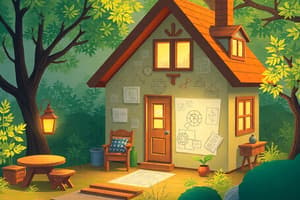Podcast
Questions and Answers
What is the average cost of a traditional house in the United States?
What is the average cost of a traditional house in the United States?
- $375,000 (correct)
- $700,000
- $20,000
- $50,000
How much do monthly expenses for tiny home owners typically cost?
How much do monthly expenses for tiny home owners typically cost?
- $700 (correct)
- $500
- $1,500
- $1,000
What was the size of Jay Shafer's tiny home?
What was the size of Jay Shafer's tiny home?
- 500
- 200
- 1000
- 96 (correct)
What benefit does living in a tiny home provide in terms of household activities?
What benefit does living in a tiny home provide in terms of household activities?
What motivated people to become interested in tiny homes after the 1990s?
What motivated people to become interested in tiny homes after the 1990s?
What is a lifestyle change associated with tiny home living according to Jay Shafer?
What is a lifestyle change associated with tiny home living according to Jay Shafer?
What is a notable financial advantage of owning a tiny home?
What is a notable financial advantage of owning a tiny home?
What was one outcome that Jay Shafer experienced from living in a tiny home?
What was one outcome that Jay Shafer experienced from living in a tiny home?
What is one main advantage of tiny homes compared to traditional houses?
What is one main advantage of tiny homes compared to traditional houses?
What percentage of U.S. adults would consider buying a tiny home?
What percentage of U.S. adults would consider buying a tiny home?
Which of the following statements is true about tiny homes?
Which of the following statements is true about tiny homes?
What is a common price range for a tiny home in the U.S.?
What is a common price range for a tiny home in the U.S.?
What distinguishes homes on wheels from traditional houses?
What distinguishes homes on wheels from traditional houses?
Why might tiny homes be considered environmentally friendly?
Why might tiny homes be considered environmentally friendly?
What factor can potentially limit the placement of tiny homes?
What factor can potentially limit the placement of tiny homes?
What does living in a tiny home encourage individuals to reassess?
What does living in a tiny home encourage individuals to reassess?
What is the typical size range of tiny homes?
What is the typical size range of tiny homes?
How many tiny homes could fit inside the average U.S. house?
How many tiny homes could fit inside the average U.S. house?
What is a reported benefit of living in tiny homes?
What is a reported benefit of living in tiny homes?
Which of the following energy sources are mentioned as beneficial for tiny homes?
Which of the following energy sources are mentioned as beneficial for tiny homes?
What percentage of Americans showed interest in living in a tiny home of 600 square feet or less?
What percentage of Americans showed interest in living in a tiny home of 600 square feet or less?
Which statement about lofts in tiny homes is accurate?
Which statement about lofts in tiny homes is accurate?
What is the average size of a U.S. house compared to tiny homes?
What is the average size of a U.S. house compared to tiny homes?
Which of the following is NOT a characteristic of tiny homes?
Which of the following is NOT a characteristic of tiny homes?
Flashcards are hidden until you start studying
Study Notes
Tiny Homes - Costs
- The average cost of a traditional home in the United States is $375,000.
- The average cost of a tiny home is $20,000 to $50,000.
- The average monthly cost of owning a tiny home is about $700 which includes parking, water, electricity, and internet.
Tiny Homes- Size and Design
- Tiny homes are typically between 100 and 400 square feet in size.
- The average US home is 2600 square feet.
- 6.5 tiny homes could fit inside one average US home.
- Some tiny homes use a loft to maximize space.
- Tiny homes on wheels can be moved to different locations.
Tiny Home Movement
- The tiny home movement started in 2000 when University of Iowa professor Jay Shafer wrote a newspaper article about his tiny home.
- In 1998, a book about living in small spaces was published which sparked interest in the concept.
- A 2018 survey found that 53% of Americans would consider living in a home of 600 square feet or less.
The Advantages of Living in a Tiny Home
- Tiny homes are significantly cheaper to buy and maintain than traditional homes.
- Tiny homes encourage people to prioritize owning only what they need and minimizing belongings.
- Having less to clean and maintain allows homeowners more time for activities they enjoy.
- Owners can spend more time outside and in their communities.
- Tiny homes have a smaller environmental footprint because they use less land, water, and energy.
- Tiny homes can be completely powered by solar panels often at a lower cost than a traditional home.
- The movement encourages people to build strong ties with their communities.
Studying That Suits You
Use AI to generate personalized quizzes and flashcards to suit your learning preferences.




